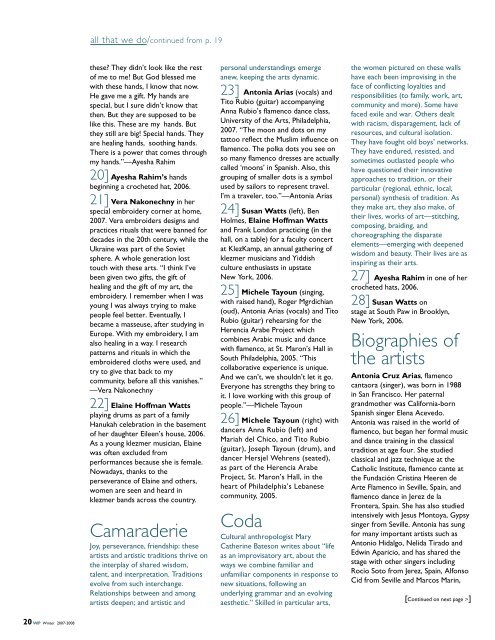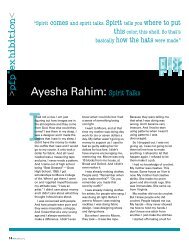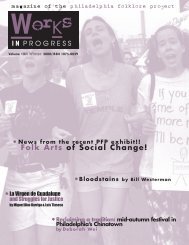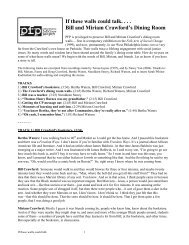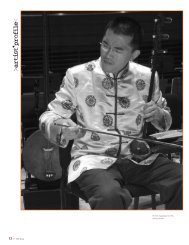African song / Fatu Gayflor ⢠War and wealth - Philadelphia Folklore ...
African song / Fatu Gayflor ⢠War and wealth - Philadelphia Folklore ...
African song / Fatu Gayflor ⢠War and wealth - Philadelphia Folklore ...
Create successful ePaper yourself
Turn your PDF publications into a flip-book with our unique Google optimized e-Paper software.
all that we do/continued from p. 19<br />
these? They didn’t look like the rest<br />
of me to me! But God blessed me<br />
with these h<strong>and</strong>s, I know that now.<br />
He gave me a gift. My h<strong>and</strong>s are<br />
special, but I sure didn’t know that<br />
then. But they are supposed to be<br />
like this. These are my h<strong>and</strong>s. But<br />
they still are big! Special h<strong>and</strong>s. They<br />
are healing h<strong>and</strong>s, soothing h<strong>and</strong>s.<br />
There is a power that comes through<br />
my h<strong>and</strong>s.”—Ayesha Rahim<br />
20] Ayesha Rahim’s h<strong>and</strong>s<br />
beginning a crocheted hat, 2006.<br />
21] Vera Nakonechny in her<br />
special embroidery corner at home,<br />
2007. Vera embroiders designs <strong>and</strong><br />
practices rituals that were banned for<br />
decades in the 20th century, while the<br />
Ukraine was part of the Soviet<br />
sphere. A whole generation lost<br />
touch with these arts. “I think I’ve<br />
been given two gifts, the gift of<br />
healing <strong>and</strong> the gift of my art, the<br />
embroidery. I remember when I was<br />
young I was always trying to make<br />
people feel better. Eventually, I<br />
became a masseuse, after studying in<br />
Europe. With my embroidery, I am<br />
also healing in a way. I research<br />
patterns <strong>and</strong> rituals in which the<br />
embroidered cloths were used, <strong>and</strong><br />
try to give that back to my<br />
community, before all this vanishes.”<br />
—Vera Nakonechny<br />
22] Elaine Hoffman Watts<br />
playing drums as part of a family<br />
Hanukah celebration in the basement<br />
of her daughter Eileen’s house, 2006.<br />
As a young klezmer musician, Elaine<br />
was often excluded from<br />
performances because she is female.<br />
Nowadays, thanks to the<br />
perseverance of Elaine <strong>and</strong> others,<br />
women are seen <strong>and</strong> heard in<br />
klezmer b<strong>and</strong>s across the country.<br />
Camaraderie<br />
Joy, perseverance, friendship: these<br />
artists <strong>and</strong> artistic traditions thrive on<br />
the interplay of shared wisdom,<br />
talent, <strong>and</strong> interpretation. Traditions<br />
evolve from such interchange.<br />
Relationships between <strong>and</strong> among<br />
artists deepen; <strong>and</strong> artistic <strong>and</strong><br />
personal underst<strong>and</strong>ings emerge<br />
anew, keeping the arts dynamic.<br />
23] Antonia Arias (vocals) <strong>and</strong><br />
Tito Rubio (guitar) accompanying<br />
Anna Rubio’s flamenco dance class,<br />
University of the Arts, <strong>Philadelphia</strong>,<br />
2007. “The moon <strong>and</strong> dots on my<br />
tattoo reflect the Muslim influence on<br />
flamenco. The polka dots you see on<br />
so many flamenco dresses are actually<br />
called ‘moons’ in Spanish. Also, this<br />
grouping of smaller dots is a symbol<br />
used by sailors to represent travel.<br />
I’m a traveler, too.”—Antonia Arias<br />
24] Susan Watts (left), Ben<br />
Holmes, Elaine Hoffman Watts<br />
<strong>and</strong> Frank London practicing (in the<br />
hall, on a table) for a faculty concert<br />
at KlezKamp, an annual gathering of<br />
klezmer musicians <strong>and</strong> Yiddish<br />
culture enthusiasts in upstate<br />
New York, 2006.<br />
25] Michele Tayoun (singing,<br />
with raised h<strong>and</strong>), Roger Mgrdichian<br />
(oud), Antonia Arias (vocals) <strong>and</strong> Tito<br />
Rubio (guitar) rehearsing for the<br />
Herencia Arabe Project which<br />
combines Arabic music <strong>and</strong> dance<br />
with flamenco, at St. Maron’s Hall in<br />
South <strong>Philadelphia</strong>, 2005. “This<br />
collaborative experience is unique.<br />
And we can’t, we shouldn’t let it go.<br />
Everyone has strengths they bring to<br />
it. I love working with this group of<br />
people.”—Michele Tayoun<br />
26] Michele Tayoun (right) with<br />
dancers Anna Rubio (left) <strong>and</strong><br />
Mariah del Chico, <strong>and</strong> Tito Rubio<br />
(guitar), Joseph Tayoun (drum), <strong>and</strong><br />
dancer Hersjel Wehrens (seated),<br />
as part of the Herencia Arabe<br />
Project, St. Maron’s Hall, in the<br />
heart of <strong>Philadelphia</strong>’s Lebanese<br />
community, 2005.<br />
Coda<br />
Cultural anthropologist Mary<br />
Catherine Bateson writes about “life<br />
as an improvisatory art, about the<br />
ways we combine familiar <strong>and</strong><br />
unfamiliar components in response to<br />
new situations, following an<br />
underlying grammar <strong>and</strong> an evolving<br />
aesthetic.” Skilled in particular arts,<br />
the women pictured on these walls<br />
have each been improvising in the<br />
face of conflicting loyalties <strong>and</strong><br />
responsibilities (to family, work, art,<br />
community <strong>and</strong> more). Some have<br />
faced exile <strong>and</strong> war. Others dealt<br />
with racism, disparagement, lack of<br />
resources, <strong>and</strong> cultural isolation.<br />
They have fought old boys’ networks.<br />
They have endured, resisted, <strong>and</strong><br />
sometimes outlasted people who<br />
have questioned their innovative<br />
approaches to tradition, or their<br />
particular (regional, ethnic, local,<br />
personal) synthesis of tradition. As<br />
they make art, they also make, of<br />
their lives, works of art—stitching,<br />
composing, braiding, <strong>and</strong><br />
choreographing the disparate<br />
elements—emerging with deepened<br />
wisdom <strong>and</strong> beauty. Their lives are as<br />
inspiring as their arts.<br />
27] Ayesha Rahim in one of her<br />
crocheted hats, 2006.<br />
28] Susan Watts on<br />
stage at South Paw in Brooklyn,<br />
New York, 2006.<br />
Biographies of<br />
the artists<br />
Antonia Cruz Arias, flamenco<br />
cantaora (singer), was born in 1988<br />
in San Francisco. Her paternal<br />
gr<strong>and</strong>mother was California-born<br />
Spanish singer Elena Acevedo.<br />
Antonia was raised in the world of<br />
flamenco, but began her formal music<br />
<strong>and</strong> dance training in the classical<br />
tradition at age four. She studied<br />
classical <strong>and</strong> jazz technique at the<br />
Catholic Institute, flamenco cante at<br />
the Fundación Cristina Heeren de<br />
Arte Flamenco in Seville, Spain, <strong>and</strong><br />
flamenco dance in Jerez de la<br />
Frontera, Spain. She has also studied<br />
intensively with Jesus Montoya, Gypsy<br />
singer from Seville. Antonia has sung<br />
for many important artists such as<br />
Antonio Hidalgo, Nelida Tirado <strong>and</strong><br />
Edwin Aparicio, <strong>and</strong> has shared the<br />
stage with other singers including<br />
Rocio Soto from Jerez, Spain, Alfonso<br />
Cid from Seville <strong>and</strong> Marcos Marin,<br />
[Continued on next page >]<br />
20 WIP Winter 2007-2008


